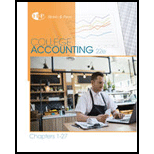
College Accounting, Chapters 1-27
23rd Edition
ISBN: 9781337794756
Author: HEINTZ, James A.
Publisher: Cengage Learning,
expand_more
expand_more
format_list_bulleted
Question
Chapter 23A, Problem 2SEA
To determine
Compute the amount of cash paid for merchandise in 20-2.
Expert Solution & Answer
Want to see the full answer?
Check out a sample textbook solution
Students have asked these similar questions
How much is the over or under applied overhead of this general accounting question?
Quick answer of this accounting questions
Solve this financial accounting problem
Chapter 23A Solutions
College Accounting, Chapters 1-27
Ch. 23A - Describe the direct method of reporting cash flows...Ch. 23A - Prob. 2RQCh. 23A - Prob. 3RQCh. 23A - Under the direct method of preparing a statement...Ch. 23A - Under the direct method of preparing a statement...Ch. 23A - CASH RECEIVED FROM CUSTOMERS Potts Companys sales...Ch. 23A - Prob. 2SEACh. 23A - Prob. 3SEACh. 23A - Prob. 4SEACh. 23A - Prob. 5SPA
Ch. 23A - COMPUTE CASH PROVIDED BY OPERATING ACTIVITIES Horn...Ch. 23A - EXPANDED STATEMENT OF CASH FLOWS Financial...Ch. 23A - CASH RECEIVED FROM CUSTOMERS Boyd Companys sales...Ch. 23A - Prob. 2SEBCh. 23A - Prob. 3SEBCh. 23A - Prob. 4SEBCh. 23A - Prob. 5SPBCh. 23A - COMPUTE CASH PROVIDED BY OPERATING ACTIVITIES...Ch. 23A - EXPANDED STATEMENT OF CASH FLOWS Financial...
Knowledge Booster
Similar questions
- What is the company's dividend payout ratio of this financial accounting question?arrow_forwardDuring November, 10,000 units were produced. The standard quantity of material allowed per unit was 12 pounds at a standard cost of $4 per pound. If there was an unfavorable usage variance of $25,020 for November, what amount must be the actual quantity of materials used?arrow_forwardQuestionarrow_forward
- Zendta Corporation, a firm with no net debt, reports cash flow from operations of $5,120 million in its cash flow statement after adding $1,750 million in accruals to earnings. It reported cash investments in operations of $3,025 million. What were Zendta Corporation's free cash flow and earnings for the period?arrow_forwardHow will net income be affected for this financial accounting question?arrow_forwardIf Nixon Corporation had a net income of $420,000 in 2018 and it experienced a 19.8% increase in net income for 2019, what is its net income for 2019?arrow_forward
arrow_back_ios
SEE MORE QUESTIONS
arrow_forward_ios
Recommended textbooks for you
 Financial And Managerial AccountingAccountingISBN:9781337902663Author:WARREN, Carl S.Publisher:Cengage Learning,
Financial And Managerial AccountingAccountingISBN:9781337902663Author:WARREN, Carl S.Publisher:Cengage Learning, College Accounting, Chapters 1-27AccountingISBN:9781337794756Author:HEINTZ, James A.Publisher:Cengage Learning,
College Accounting, Chapters 1-27AccountingISBN:9781337794756Author:HEINTZ, James A.Publisher:Cengage Learning, Financial AccountingAccountingISBN:9781337272124Author:Carl Warren, James M. Reeve, Jonathan DuchacPublisher:Cengage Learning
Financial AccountingAccountingISBN:9781337272124Author:Carl Warren, James M. Reeve, Jonathan DuchacPublisher:Cengage Learning Cornerstones of Financial AccountingAccountingISBN:9781337690881Author:Jay Rich, Jeff JonesPublisher:Cengage Learning
Cornerstones of Financial AccountingAccountingISBN:9781337690881Author:Jay Rich, Jeff JonesPublisher:Cengage Learning

Financial And Managerial Accounting
Accounting
ISBN:9781337902663
Author:WARREN, Carl S.
Publisher:Cengage Learning,

College Accounting, Chapters 1-27
Accounting
ISBN:9781337794756
Author:HEINTZ, James A.
Publisher:Cengage Learning,

Financial Accounting
Accounting
ISBN:9781337272124
Author:Carl Warren, James M. Reeve, Jonathan Duchac
Publisher:Cengage Learning

Cornerstones of Financial Accounting
Accounting
ISBN:9781337690881
Author:Jay Rich, Jeff Jones
Publisher:Cengage Learning